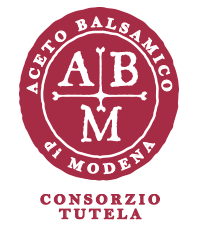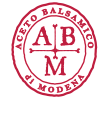At the origin of the product
Balsamic Vinegar of Modena (Aceto Balsamico di Modena) is produced from grape must that is fermented and/or cooked and/or concentrated.
The grapes comes only from Lambrusco, Sangiovese, Trebbiano, Albana, Ancellotta, Fortana and Montuni vines.
To the grape must are added wine vinegar, in the minimum amount of 10%, and an amount of at least 10-year-old aged vinegar.
Characteristics of the grape musts
The minimum percentage of grape must is 20% of the total quantity of the product to be sent to processing. The concentration is carried on until the initial mass of must reaches a density no lower than 1.240 at a temperature of 20°C. In addition to coming from the vines listed above, the musts – only the cooked and concentrated ones – must have a minimum total acidity of 8 gr/kg and a minimum net dry extract of 55 gr/kg. Caramel may be added for colour stability, up to a maximum of 2% of the finished product. No other substances may be added.
Acetification and maturation
The processing of Balsamic Vinegar of Modena (Aceto Balsamico di Modena) takes place with the traditional method of acetification through the use of selected bacterial colonies or with the lenta in superficie (slow surface) or lenta “a truciolo” (slow wood shavings) methods. Next comes the maturation phase: acetification and maturation both take place in barrels, vats or casks made from precious woods, such as sessile oak, chestnut, oak, mulberry and juniper. The minimum maturation time is 60 days, counted from the moment in which the raw materials, mixed in the right proportions, are sent to processing. At the end of the maturation period, analytic and organoleptic tests are carried out on the resulting product by a group of expert technicians and tasters: these tests must be successful for the product be certified as Balsamic Vinegar of Modena (Aceto Balsamico di Modena).
Ageing
Once the 60-day maturation stage in wooden vats has been completed, Balsamic Vinegar of Modena (Aceto Balsamico di Modena) can be further aged. If this phase lasts over three years, the finished product can boast the “aged” classification.
Packaging
Balsamic Vinegar of Modena (Aceto Balsamico di Modena) obtained this way is ready for direct consumption. It is transferred into glass, wooden, earthenware or terracotta containers of different capacity: 0.250L; 0.500L; 0.750L; 1L; 2L; 3L or 5L. Single-portion sachets in plastic or composite materials, with a maximum capacity of 25 ml, are also allowed. If the product is intended for professional use, the minimum capacity of glass, wooden, earthenware or terracotta containers is 5L, while the minimum capacity of plastic containers is 2L.
Labelling
The packaging must bear the words Aceto Balsamico di Modena, together with the Protected Geographical Indication. If the product was aged for more than three years, the packaging also bears the word “Aged”. Producers associated with the Protection Consortium are allowed to display the Consortium logo on the label.
Territorial constraints
The Balsamic Vinegar of Modena (Aceto Balsamico di Modena) production specifications require that the assembly of raw materials, processing, maturation and/or ageing in containers from precious wood must take place in the provinces of Modena and Reggio Emilia. The finished product can, however, be packaged outside of the geographical area of origin.











